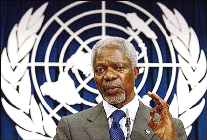FACTBOX-Sudan, struggles from all points of the compass
LONDON, April 11 (Reuters) – Donors at a two-day conference in Norway exceeded Sudan’s aid requests by pledging $4.5 billion on Tuesday to help southern Sudan recover from a civil war but Washington said the aid hinged on ending atrocities in Darfur.

|
|
U.N. Secretary-General Kofi Annan speaks during a news conference at the international conference on aid for Sudan in Oslo April 11, 2005. (Reuters). |
Here are some key facts on Sudan and its conflicts:
* Sudan is Africa’s largest country with an area of 2.5 million sq km (967,500 sq miles). It straddles the middle reaches of the Nile and is bordered by Egypt to the north; the Red Sea, Ethiopia and Eritrea to the east; Kenya, Uganda and the Democratic Republic of Congo to the south; and the Central African Republic, Chad and Libya to the west.
The north-south conflict:
* In 1983, the Sudan People’s Liberation Army (SPLA), the main southern rebel group led by John Garang, launched a war against the northern-based government, partly sparked by the imposition of Islamic sharia law by the then-government.
* The war pitted the black African south, which is mainly Christian and animist, against the mainly Muslim, Arabic-speaking north. The war is complicated by tribal and factional fighting, as well as the conflict over oil.
* Oil exploration began in the 1970s, but operations were repeatedly interrupted by war, with southern rebels laying claim to oil fields that provided the government with vital revenue.
* In 2004, a deal, sealed by the southern rebel Sudan People’s Liberation Army (SPLA) and the Khartoum government, cleared the way for a comprehensive peace to end the 21-year-old civil war in the south that claimed more than 2 million lives.
* Eight peace protocols were signed in January including:
— The South will have the right to vote for secession at the end of a six-year interim period during which Islamic sharia law will apply in the north but not in the south.
— Fifty percent of net oil revenue derived from oil in southern Sudan shall be allocated to the government of southern Sudan at the beginning of the pre-interim period. The remaining 50 percent to go to the national government and northern states.
Darfur in the west:
* Rebels rose up against the government in February 2003 saying Khartoum discriminated against non-Arab farmers in Darfur in favour of Arab tribes. More than 2 million Muslim Darfuris, mainly subsistence farmers from a wide variety of ethnic groups for whom Arabic is a second language, have fled their homes.
* Arab militias known as the Janjaweed, with the connivance of the Sudanese army, drove farmers from their land in a campaign rights groups said amounted to ethnic cleansing and the United States has called genocide.
* The Sudanese government has said the Janjaweed are outlaws and has vowed to disarm them. The United Nations has said Sudan has done very little to disarm the Arab militias.
* Tens of thousands of people have died from disease and starvation during the years of fighting, as well as violence.
* The prospect of peace in a separate conflict in the south of Sudan may have emboldened the rebels to believe they could win a better deal by resorting to arms, analysts say.
Shilluk Kingdom in the south:
* Conflict sprung up last year in the Shilluk Kingdom of Upper Nile region in eastern Sudan, described by one regional observer as “another Darfur”.
* The United Nations said last June 50,000 to 70,000 people have been displaced in Shilluk in fighting between government forces and SPLA rebels.
* Analysts said the fighting in Shilluk followed senior Shilluk politician Lam Akol’s decision in October 2003 to rejoin the SPLA more than 10 years after he broke from the movement.
